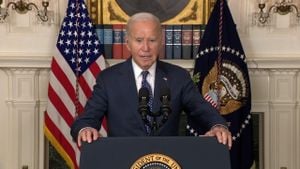Donald Trump is back, and his return to the political forefront has stirred quite the conversation about its potential effects on global relations, especially concerning China and Taiwan. Amidst this backdrop, Xi Jinping, the Chinese President, has recently extended what may appear as an olive branch; yet, it’s laced with firm red lines meant to clarify Beijing’s expectations moving forward.
During his eleventh-hour meeting with Joe Biden before the latter's departure from the White House, Xi expressed China’s desire for friendship with the United States, but with strings attached. The high-stakes meeting, held at the APEC summit, was perhaps Xi's way of laying groundwork for managing future interactions with Trump's administration. China is anxious about Trump's hawkish stance toward its government and has warned against actions by the U.S. aimed at undermining the Communist Party's authority or supporting Taiwan's independence.
Xi highlighted four non-negotiable areas — the Communist Party's grip on power, economic growth, democratic movements, and Taiwanese independence — which he insisted Trump must respect. State media outlets mobilized quickly to report these conditions, underscoring their significance for the two leading economic powers on the planet. Xi’s remarks suggest he is both hopeful for collaboration yet braced for retaliation if provoked.
Trump's foreign policy is expected to mark another shift, with calls to possibly impose hefty tariffs against China, reminiscent of his first run as president. His approach could hinge on negotiating tactics aimed at reviving discussions or acting on aggressive trade posturing. Top business figures, including JPMorgan Chase CEO Jamie Dimon, have interpreted Trump's tariff threats as positioning for negotiations rather than the start of outright conflict.
At the moment, the headlines echo Trump's turbulent relationship with Taiwan, particularly after Elon Musk's comments labeling the island as "integral" to China. For many observers, this reflects the delicate balancing act Trump will have to perform. On one hand, he has shown willingness to discuss economic matters with Xi, but on the other, any misstep could provoke China’s ire concerning Taiwan, which remains Taiwan’s core issue.
Just to add complexity, Xi also stressed to Biden the necessity for the U.S. to steer clear of entanglements with regional partners like the Philippines and not fan the flames of territorial disputes. This reflects China’s sensitivity to any perceived Western interference, particularly concerning its own regional tensions.
U.S.-China relations were also underscored by Xi's comments distancing current diplomatic efforts from human rights discussions and democracy, as China braces for potential unrest at home from its growing economic issues. The emphasis on avoiding provocations serves as both encouragement for dialogue and caution for the U.S. to tread lightly around sensitive topics.
This intricacy marks the current atmosphere as Trump re-emerges where international leaders are on alert, watching how his past actions might resurface. With Trump spotting hard-nosed advisors like Marco Rubio and Mike Waltz beneath him, many anticipate no easy conversations will take place. His cabinet choices signal strong opposition on various fronts, including Taiwan’s status and other contentious issues.
It’s likely Trump will adopt tactics aiming for gains similar to the maneuvering he performed during his presidency — negotiating heft with tariffs to encourage economic concessions without necessarily igniting full-blown trade wars. History shows his approach has oscillated between confrontational and collaborative based on how he assesses the responses of foreign leaders.
The question looms: Will Trump’s return ignite renewed tensions with China significantly beyond posturing and tariffs? Or can he strike new accords fostering dialogue and trade? One thing is for sure; Xi’s cautionary red lines provide clear notice of how China may react if interests clash. Analysts are left to ponder whether this is merely the opening act of another international drama between two global giants.
On the world stage, Trump’s comeback has extended beyond economic policies, reaching to military strategies too. A closer look shows Trump aligning with countries opposing China’s influence, accelerating arms sales to Taiwan or echoing sentiments of U.S. military support to regions influential for their strategic importance.
Under Trump, the U.S. position on territorial disputes involving China and its neighbors is under sharpened scrutiny. Whereas Biden sought to manage relations through direct engagement, Trump’s method may lean toward imposing buffers against perceived Chinese dominance.
Nonetheless, the broader conversation revolves around the balance of power. Global watchers are keeping track of shifting allegiances as Trump's administration morphs and reshapes strategies facing Western allies and China. If Trump’s narrative veers toward confrontation, the geopolitical chessboard is set for serious overhaul — heightened risks could emerge should disputes over Taiwan ignite.
Notably, Taiwan remains particularly salient for China, which views any form of independence movement as infringing on its sovereignty. Therefore, any rhetoric or actions from Trump signaling support for Taiwanese self-determination might evoke stiffened responses from Beijing.
Further complicate the web is the tug-and-pull of U.S.-led alliances with nations like Japan and South Korea backing Taiwan. The dynamic increases pressure for the U.S. to reassess its commitments within Asia-Pacific relations. It’s no secret these alliances, along with mere presence of U.S. military assets within the region, rattle Beijing.
Meanwhile, the climate within China itself isn’t stagnant; internal economic pressures fuel societal frustrations, creating potential for dissent. Xi’s cautious narrative of avoiding unrest hints at wary governmental oversight on rapid economic transitions. Observers reveal the internal discourse could spark unrest if the government appears to struggle under the weight of its challenges.
Overall, as Trump reasserts influence, the air thickens with tensions and potential volatility. With gearing toward negotiations and interactions closely trailing his cabinet picks, dialogues echo the latest trends. Whether Xi and Trump will find pathways to collaboration or instead redraw battle lines remains the $64 million question.
For now, stakeholders will be watching closely, measuring each pronouncement and diplomatic overture along the way. The ensuing weeks promise to reshape how the U.S. and China navigate the future, together or apart, under the specter of Trump’s ambitions.



